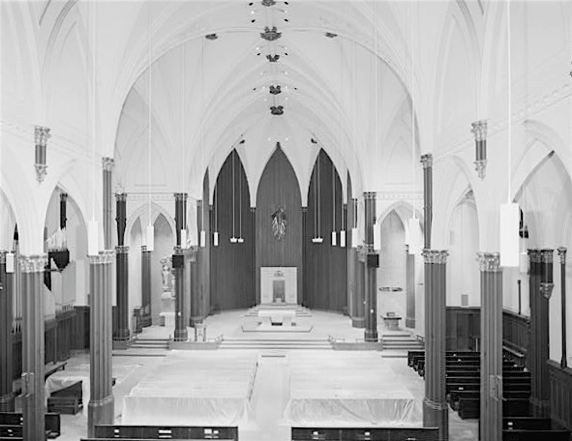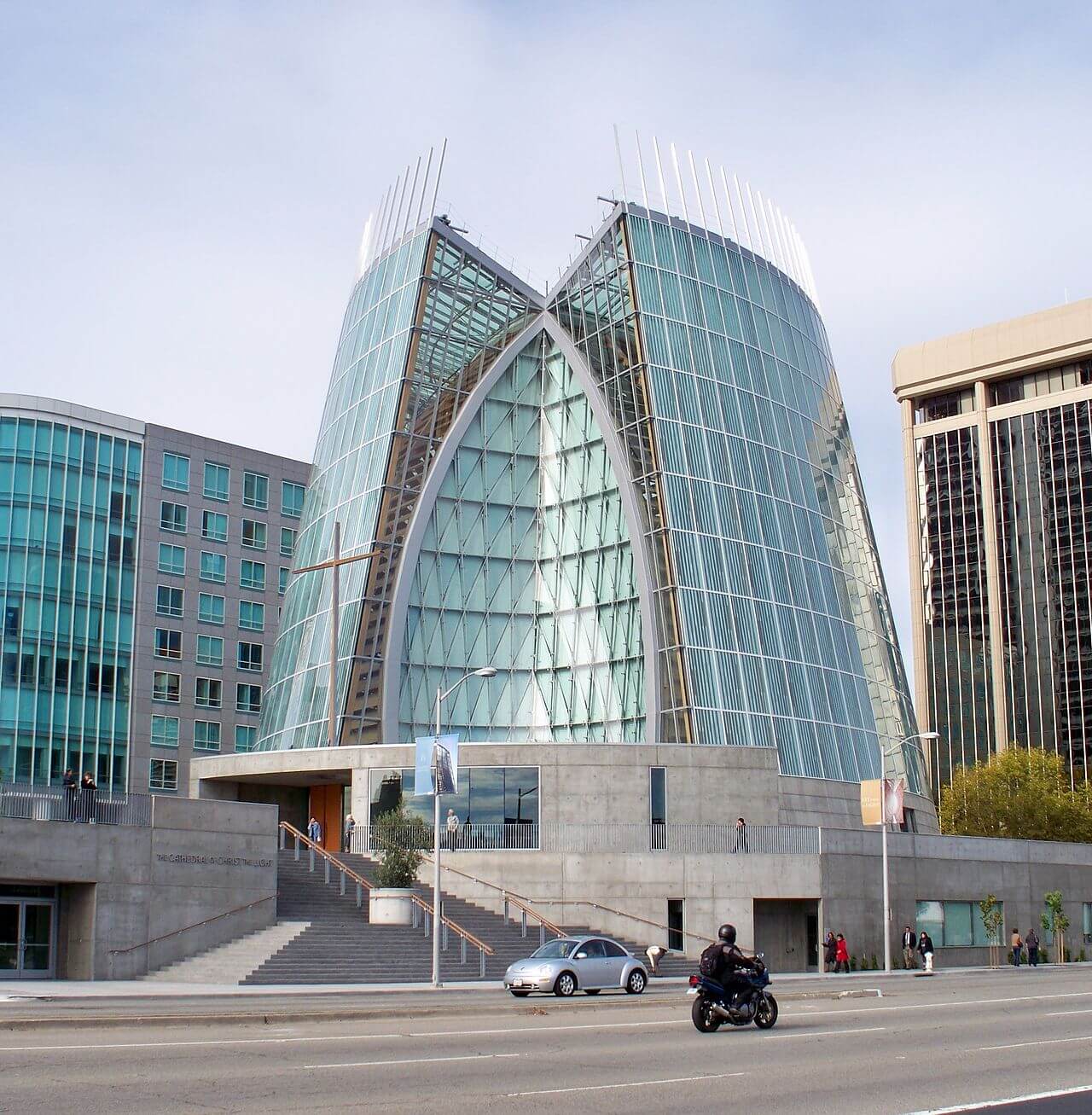I've almost wept at seeing the destruction wrought by the post-Conciliar 'liturgists' on beautiful old Churches here in the Midwest and in Canada.
From One Peter Five
By Reid Turner
The bishops who came home from Vatican II (or the “liturgist” wolves they failed to stop) initiated acts of violent destruction and iconoclasm in the name of the Council. The zeal for change disparaged the Church’s heritage and liturgical tradition and naturally influenced its architecture and design. This ended up destroying the monuments that our fathers sacrificed to build and pass down to us. The saga of the two Cathedrals of the Diocese of Oakland, California is a clear example.
Built in 1893 (photo above), the neo-gothic St. Francis de Sales was built
With funds from an Irish immigrant, Mrs. Mary J. Canning, the church had already served its growing population for many decades as a lively hub in central Oakland.
The parish became an early center of ethnic richness during World War II, when shipbuilders and servicemen and women of many backgrounds settled there with their families.

Exterior, 1893

Interior
This beautiful monument built by our fathers to God’s greater glory and the salvation of souls would eventually have the honor of becoming “…the first cathedral in the United States to be completely remodeled according to the liturgical spirit of the Second Vatican Council.”[1]
Bishop Floyd Begin had attended every session of the Council, claiming even to have participated in authoring some of its documents. Burns and Bautista report that when he returned after its conclusion, he had a bold plan for redesigning his cathedral:
With the priest now facing the people, the bishop found the venerable stained-glass windows behind the altar distracting. ‘The rather colorful windows in the sanctuary impeded the vision of the service, just like the headlights of an oncoming car do.’ The stained-glass windows were covered over by redwood paneling. The interior was whitewashed, and the exterior [brick] was painted in a creme color. The altar rail was removed as were all the statues, except for that of Jesus. In sum, the remodeled building followed Vatican II directives and created ‘…an atmosphere conducive to participation, worship, and prayer’ (p.51). [emphasis added]

Renovation
Unsurprisingly, the council’s “liturgical spirit” led to the incorporation of elements from contemporary society:
Dance, slide presentations, photography, innovative preaching [?], all became regular features in the Cathedral liturgies. …In late 1969, the Cathedral featured an Advent series entitled ‘We Hold a Strange Hope’ to explore how to maintain hope in the midst of the social chaos that was engulfing the United States. The first week featured four blown-up portraits hanging in the sanctuary — Che Guevara, Joan Baez, the Rev. Martin Luther King Jr., and Neil Armstrong [?] (p.52).
A strange hope indeed. The organ was replaced by an ensemble of strings, brass, piano, and various musicians. These liturgical innovations attracted national attention and were featured in Time Magazine:
Twice each Sunday, the music runs the scale between such unlikely extremes as Gregorian chant and rock. On one recent Sunday, the mixture embraced both Bach’s Aire for the G-String and Amazing Grace. On another, included a Hayden trio, Bob Dylan’s The Times They are A-Changin’ and Luther’s A Mighty Fortress is our God.’[2]
Burns and Bautista triumphantly conclude, “In short, the Cathedral liturgy was achieving what the council had mandated” (p.53). [Emphasis added]
Of course, the council never mandated such nonsense; it just left the door open to it. According to the specific document dealing with the reform at the local level, Sacrosanctum Concillium, there were strict, but vague limitations on what the bishop could approve:
…[T]here must be no innovations unless the good of the Church genuinely and certainly requires them; and care must be taken that any new forms adopted should in some way grow organically from forms already existing (Article 23).
St. Francis de Sales was eventually destroyed in an earthquake, which would leave the diocese without a cathedral for twenty years.
But then it happened again!
The post-modernist Cathedral of Christ the Light was finally completed in 2008 at a cost of almost 200 million. While in the case of St. Francis de Sales it was the bishop’s interpretation of the council’s reforms that guided his remodeling of the Cathedral, the design of the new structure was left to a competition among professional architects. A thoughtful critique came from the respected architectural theorist Nikos Salingaros:
In the Oakland Cathedral I find imagery and architectural fashion used in a gratuitous manner, despite the apparently good intentions. …Excitement is fine for good times, but does it help you in the long term? Does not the same concept hold for the Church itself?

Exterior

Interior
The professor described the cathedral as both modern and postmodern, with deconstructivist elements throughout, a style known as “controlled chaos.” The intentional break with the past was most evident in the use of “brutalist concrete,” which Salingaros called “the dead giveaway”:
This material is, in my opinion, fundamentally unholy. Gray, damp, and acoustically hard, it represents the opposite of the welcoming surface of a place of worship. For millennia, church surfaces were finished in materials that conveyed a love for the Creator. I see no love in this most unfriendly material.
Instead of bishops insisting on the incorporation of Christian typologies in their architectural designs, writes Salingaros, “…architects have resorted to using typologies from the modernist form language.”
Regarding modern church architecture, New York Times columnist and Catholic convert Ross Douthat observed that it ultimately lacked spirituality:
I have never seen a church or cathedral executed successfully in any of the architectural styles that have prevailed since the 1920s and ’30s. From Italy to San Francisco, the showpiece modern churches tend to succeed as monuments but fail as spaces for prayer and worship; their smaller imitators, scattered across the American suburbs, are almost always blights on whatever religious community is unhappy enough to occupy them.
Fortunately, as Salingaros points out, the modernist trend is not universal, as the recently built Cathedral of the Sacred Heart in Houston proves:
Those who support tradition over innovation in Church architecture (and in the Church itself) see no need for any further justification. The human being is tied to God through ritual over millennia, and the best architectural solutions are those developed over time. An intelligent and sensitive architect can use them in a contemporary context with great success, and that is what has been achieved here. Tried-and-true methods are used to design a building that is solid on tradition, reassuring in presenting the Church of tradition to the faithful.
[1] Jeffrey M. Burns and Mary Carmen Bautista, We are the Church: A History of the Diocese of Oakland. Strasbourg: Editions du Singe, 2001, p. 51.
[2] “Troubadours for God”, Time (May 24, 1971).
No comments:
Post a Comment
Comments are subject to deletion if they are not germane. I have no problem with a bit of colourful language, but blasphemy or depraved profanity will not be allowed. Attacks on the Catholic Faith will not be tolerated. Comments will be deleted that are republican (Yanks! Note the lower case 'r'!), attacks on the legitimacy of Pope Francis as the Vicar of Christ (I know he's a material heretic and a Protector of Perverts, and I definitely want him gone yesterday! However, he is Pope, and I pray for him every day.), the legitimacy of the House of Windsor or of the claims of the Elder Line of the House of France, or attacks on the legitimacy of any of the currently ruling Houses of Europe.